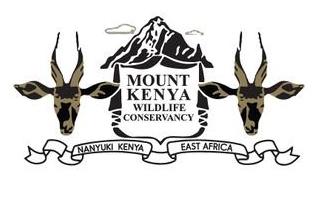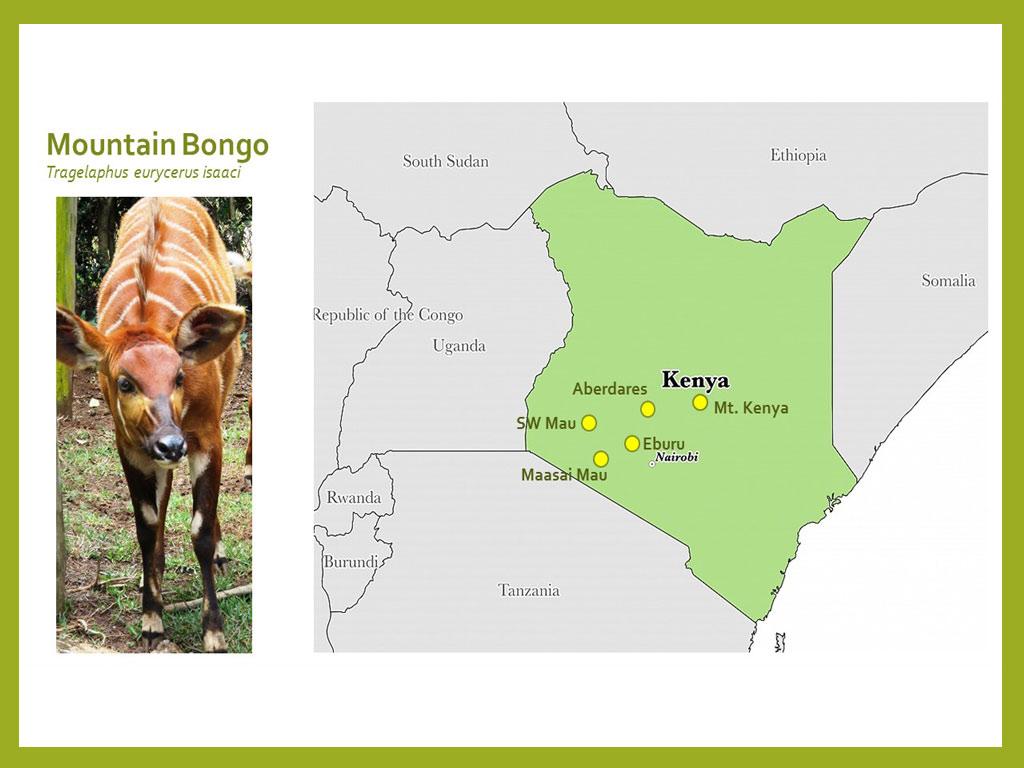About Mountain Bongos
From the Florida University Tropical Conervation website:
The Mountain Bongo (Tragelaphus eurycerus isaaci) is the largest and most endangered of the forest antelopes. With less than 100 left in the wild, they are listed as Critically Endangered on the IUCN Red List of Threatened Species. Bongos have undergone significant reduction in numbers and range due to habitat loss, poaching, human encroachment, and diseases. Through an international collaborative effort, our scientists are working to save the bongo and with it, the high-mountain ecosystem that supplies 80 percent of Kenya’s people with clean, fresh water.
About Bongos in Mount Kenya Rainforest
Bongos are rarely seen in large herds. Bulls are mostly solitary, while females with young form small herds of up to 10. They are mostly nocturnal. These small herds are scattered across the highlands of Mt. Kenya and the nearby Abadares.
The Mt. Kenya Trust works with the Kenya Wildlife Service (KWS), local communities and others to protect the forests of Mount Kenya. It operates patrol teams which remove traps and snares, arrest poachers and loggers, and fight forest fires. The Joint Wildlife Protection Team (JWPT) also consists of armed KWS rangers, while the Horse Patrol can reach inaccessible areas and is very effective at catching offenders. Habitat protection and monitoring of the small remaining populations is critical for their survival, while captive breeding and reintroduction to Mount Kenya could also play a role (there are more mountain bongo in captivity than in the wild). Tusk supports the Bongo Surveillance Programme, which studies and protects their largest population of about 50 in the Aberdares.
The Mawingu Mountain Bongo Sanctuary is a fundamental element of the National Recovery and Action Plan for the Mountain Bongo 2019 – 2023. The Sanctuary represents the next step in the re-wilding process for the Mountain Bongo as part of the MKWC breeding programme and will support the National Bongo Task Force in the reintroduction of the Mountain Bongo to indigenous habitats such as Ragati, Eburu, Mau and Aberdares forests.
Range Map of the Mountain Bongo
About the painting:
I had the privilege of not only seeing but feeding and petting half a dozen mountain bongos, held as part of a breeding program in the Sweetwaters Orphanage. The orphanage was home at the time (2017) to not only bongos, but colobus, sykes, and vervet monkeys, a buffalo calf, hyrax, and incongruously, several llamas.
I took many photos, and used several as reference as well as finding a Mt Kenya rainforest pool image and some stock images of bongos. In the end, I composited my head photo onto a stock body and added some red-billed oxpeckers. There was no reference for the ripples so I used images of grebes on lakes as the basis and just sort of worked the rest out in my head.
I planned the ripples out by drawing concentric ellipse paths in perspective, then applying a stroke to the paths. I used this as a guide when creating the highly detailed outlines in pencil.
For this painting, I wanted to attempt another pure watercolor – but had to resort to the tiniest overlays of gouache for the white parts of the ripple reflections.
I mixed the base green for the background and reflections using Daniel Smith’s Green Apatite Genuine, Burnt Sienna Light, and Yellow Ochre, with touches of Burnt Umber. The bongo’s unique, rich chestnut coat was made with Roasted French Ochre, Burnt Sienna Light, Yellow Ochre, Permanent Orange, and Mayan Orange.

